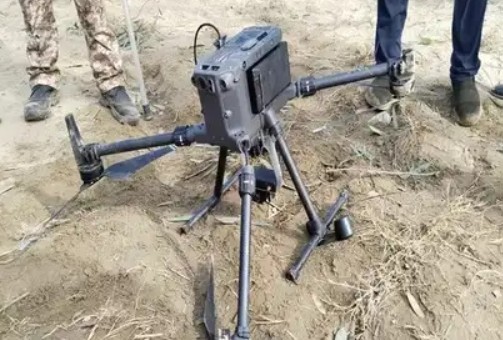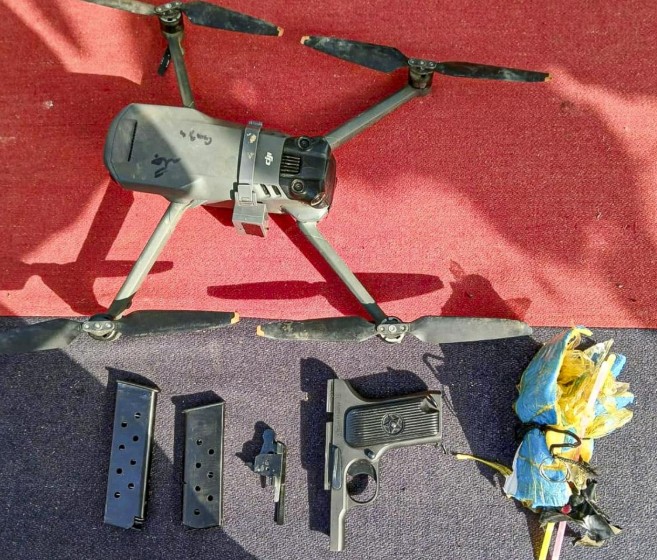A disturbing and persistent pattern of cross-border illicit activity continues to challenge India’s security apparatus along the Punjab frontier. Recent data from the Border Security Force (BSF) unequivocally confirms Pakistan’s escalating reliance on Chinese-made drones to smuggle narcotics and arms. This sophisticated and technologically advanced method of infiltration represents a grave threat to India’s national security, fuels the rampant drug menace in Punjab, and highlights the insidious role played by Pakistan’s Inter-Services Intelligence (ISI) in orchestrating what has increasingly been termed “narco-terrorism.”
The BSF, tasked with guarding India’s extensive and often porous international borders, has observed a dramatic surge in drone sightings and interceptions along the 553-kilometer Punjab stretch. The data paints a grim picture: from 110 drones recovered in 2023, the number skyrocketed to 260 in 2024, marking a staggering 136.36 percent increase. In January 2025 alone, the BSF intercepted 63 drones, indicating that the threat remains consistently high. These aren’t just random incursions; forensic analysis of recovered drones reveals that the majority originate from Pakistan’s Lahore district, with Amritsar, Gurdaspur, and Ferozepur in Punjab being the primary intended drop zones on the Indian side. Amritsar tops this list, with 184 drone sorties from Lahore targeting the district in 2024, followed by Ferozepur with 42 and Gurdaspur with 14. This precise targeting underscores a well-coordinated and deliberate strategy by Pakistani entities.
The shift from traditional land smuggling methods, which have become increasingly difficult due to enhanced border fencing and vigilance, to aerial infiltration via drones has fundamentally altered the dynamics of cross-border illicit trade. Drones offer smugglers unparalleled advantages: they can bypass physical barriers, operate under the cover of darkness, navigate difficult terrain, and significantly reduce the risk of human exposure for the handlers. This has made them the preferred mode for transporting high-value consignments of drugs, primarily heroin, and a range of arms and ammunition, including pistols, grenades, and even improvised explosive device (IED) components.
A significant concern for Indian security agencies is the origin of these drones. Forensic investigations consistently point to Chinese-made drones, predominantly from the DJI Mavic series. These are dual-purpose drones, readily available in commercial markets, but their sophisticated capabilities, including their ability to carry substantial payloads and operate with a low visual and audio signature, make them ideal for illicit purposes.

Earlier versions of these drones could carry three to four kilograms and were somewhat detectable by sound and sight, but newer models can carry smaller payloads of around 500 grams and emit virtually no sound, making interception exceedingly challenging. The continuous evolution of drone technology, often with capabilities for autonomous flight and target recognition, means that counter-drone measures must constantly adapt and improve. The fact that some recovered drones have shown flight data indicating operations over coordinates in Shanghai, China, raises even deeper questions about the supply chain and potential nexus.
The financial motive behind this drone-facilitated smuggling is immense. The proceeds from the illicit drug trade, particularly heroin, generate colossal sums of money, which are then allegedly channeled to fund various anti-India activities. Indian intelligence agencies have long asserted that Pakistan’s Inter-Services Intelligence (ISI) plays a central and orchestrating role in this “narco-terrorism” nexus.
The objective is multi-fold: to destabilize Punjab by fueling a pervasive drug addiction crisis, to finance extremist and separatist elements (including Khalistani groups) within India, and to supply them with weapons to carry out terror attacks. The surge in drone activity has ominously coincided with an increase in attacks on Punjab Police establishments in border districts, using grenades and explosives, further solidifying the link between drone-dropped consignments and internal security threats. Low-key operatives within India are often paid in narcotics, which they then sell to earn money, further integrating them into this dangerous ecosystem.
The impact on Punjab is particularly devastating. The state finds itself on the frontlines of this proxy war, battling a severe drug addiction epidemic that drains its human potential and strains its social fabric. The easy availability of narcotics, facilitated by these airborne deliveries, undermines public health, increases crime rates, and jeopardizes the future of its youth. The constant threat of arms infiltration also creates a climate of insecurity, affecting peace and stability.
In response to this escalating threat, the Border Security Force and Punjab Police have significantly ramped up their counter-drone measures. The BSF has reported successfully neutralizing 55 percent of the drones detected in Punjab, a substantial improvement from a mere 3 percent previously. This success is attributed to a multi-pronged approach.
At the heart of this strategy lies technological advancement. The BSF is actively procuring and deploying more advanced anti-drone systems. These sophisticated systems employ various technologies such as radar, optical sensors, and radio frequency monitoring to detect and track drones. They then use a combination of ‘soft kill’ options, like jamming communication signals to force a crash or diversion, and ‘hard kill’ options, which involve physically destroying the drone with guns, missiles, or even lasers. India is also investing heavily in indigenous drone technology and has acquired advanced Unmanned Aerial Vehicles (UAVs) from global partners. For instance, the Indian Army is set to acquire nine more laser-based anti-drone systems, capable of destroying drones at a range of 800 to 1000 meters.
Complementing technology is enhanced surveillance. Vulnerable points along the border are being equipped with a comprehensive network of CCTV and Pan-Tilt-Zoom (PTZ) cameras for continuous monitoring. The old border fence is simultaneously being replaced with a new, more robust design to strengthen the anti-infiltration grid and make physical breaches even more difficult.
Intelligence and coordination remain paramount. Strengthening intelligence networks and ensuring timely coordination with sister agencies, including the Punjab Police, is crucial for effective counter-operations. This collaborative approach allows for quicker response times and more effective interception of drones and their illicit payloads.
Furthermore, community engagement has emerged as a vital component of the strategy. The Punjab Police is actively engaging local populations in border regions through initiatives like the Drone Emergency Response System (DERS) and Village-Level Defense Committees (VLDCs). These committees act as the “eyes and ears” on the ground, promptly notifying authorities of any suspicious drone activity and helping to secure potential drop zones, thereby making it significantly harder for smugglers to retrieve their contraband. To further incentivize public participation, a reward scheme offering Rs 1 lakh for information leading to the seizure of weapons and drugs has also been implemented.
Finally, forensic analysis plays a critical role in understanding the adversary. Dedicated drone forensic laboratories in Delhi and Amritsar are crucial for analyzing recovered drones. These labs meticulously extract vital data such as flight paths, take-off and landing areas, and even the origin of the drone’s components, providing critical intelligence to develop future counter-strategies. The Amritsar lab, established in May 2024, has already analyzed over 200 rogue Pakistani drones, offering invaluable insights into their operations.
Despite these robust efforts, the challenge persists due to the sheer volume of attempts and the continuous evolution of smuggling tactics. The Punjab government has also stepped up, approving funds for its own anti-drone systems to serve as a crucial second line of defense, supplementing the BSF’s efforts. Nine such systems are planned for deployment along the 532-kilometer border, stretching from Pathankot to Abohar, with an estimated cost of Rs 51.41 crore.
The ongoing use of Chinese drones by Pakistan for narcotics and arms smuggling along the Punjab border is a clear and present danger. It is not merely a localized law and order issue but a significant national security threat, intricately linked to state-sponsored destabilization efforts. While India’s security forces and the Punjab government are making commendable strides in bolstering their defenses and intercepting these aerial threats, the battle against this technologically advanced form of narco-terrorism demands continuous vigilance, sustained investment in counter-drone technologies, robust intelligence gathering, and unwavering inter-agency cooperation to secure the border and protect the state’s populace.


